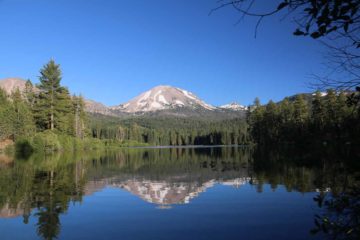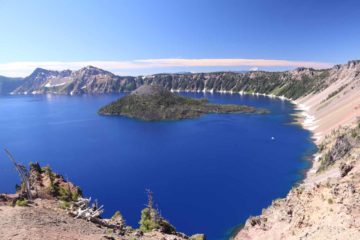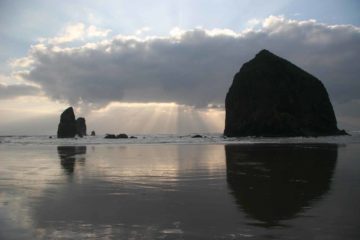About Duwee Falls
Duwee Falls was said to be Crater Lake National Park’s largest officially-named waterfall (the other two named falls in the park were Vidae Falls and Plaikni Falls; the latter we didn’t have the time to do). Although it had a reported height of some 100ft or more, if true, its height was actually less than the reported height of Vidae Falls. Nevertheless, this statistic alone (of being the largest in the park) would probably compel waterfall lovers like us to make a visit to the falls compulsory, but as you can see from the photo at the top of this page, getting a good view of the falls was not easy. We either had to be content with a very distant view (from about a mile away) from a roadside pullout (which is what’s shown at the top), or risk life and limb to try to improve the very partial views of the falls from the Godfrey Glen Trail. The difficulty rating shown at the top of this page reflects only the roadside view as we’re tempted to not even mention the Godfrey Glen option though we’ll do so anyways just to more-or-less complete what we have to say about this falls.
What made Duwee Falls rather interesting was that it appeared to have been a result of pyroclastic flows from the eruption of Mt Mazama (the same event responsible for the creation of Crater Lake) some 7,700 years ago. Pyroclastic flows are like a fast-moving landslide of a mix of hot lava material, pumice, ash, and hot gases all barreling down the mountainsides and even into drainages at speeds of 100 miles per hour often burying everything in its path very quickly. Perhaps the most famous pyroclastic flow in the history of humankind was that of the eruption of Mt Vesuvius near Naples, Italy burying the ancient city of Pompeii resulting in one of the best preserved examples of ancient human civilization known to date. When we viewed Duwee Falls, it stuck us just how tall the ash cliffs resulting from the pyroclastic flows were, which indicated how being in the path of one of these things really meant you’d have literally no chance of survival and would probably be fossilized in the process.
In any case, seepage from Crater Lake emerging as Munson Creek further downslope would ultimately erode the valley that this pyroclastic flow once occupied, and over time, the creek carved out the steep canyon responsible for Duwee Falls while also unveiling pinnacle formations in the wrinkly cliffs flanking this gorge. This was all apparent from the roadside view that we’re advocating as the method to view the falls from afar (see directions below), and an interpretive sign at the roadside pullout further explained the events that unfolded to yield the eccentric geologic features on display here. To get a closer examination of the pinnacles and the pyroclastic ash cliffs, we actually hiked part of the Godfrey Glen Trail though in hindsight, we wouldn’t recommend doing the trail if the sole purpose was to try to get a closer look at Duwee Falls. It was far too dangerous and tempting to try to improve the view on the steep and unstable cliffs.
If you are curious about catching a glimpse of Duwee Falls from the Godfrey Glen Trail, we managed to get a very partial view after hiking about 0.3 miles (according to our GPS logs) in a clockwise direction along the heart-shaped looping trail. It was very easy to miss viewing the falls from the trail because it sat deep within the ash gorge to the left. The only way to try to get satisfying views of it would be to make a real daring scramble further down into the gorge, but given the steepness and instability of the cliffs, we’d strongly recommend against doing that. We certainly didn’t bother trying. We have a photo in the photo journal down below showing just how little of the falls we were able to see from a relatively safe spot just off the Godfrey Glen Trail. That said, the Godfrey Glen Trail did allow us to examine the pyroclastic cliffs more closely as well as the ash blowing off the clifftops suggesting the erosive processes continue to this day.
Related Top 10 Lists
No Posts Found
Trip Planning Resources
Nearby Accommodations
This content is for members only. See Membership Options.Featured Images and Nearby Attractions
This content is for members only. See Membership Options.Visitor Comments:
Got something you'd like to share or say to keep the conversation going? Feel free to leave a comment below...No users have replied to the content on this page
Visitor Reviews of this Waterfall:
If you have a waterfall story or write-up that you'd like to share, feel free to click the button below and fill out the form...No users have submitted a write-up/review of this waterfall






